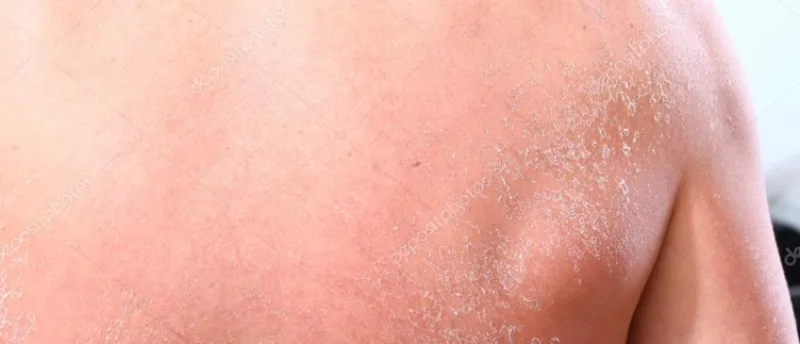A sunburn can harm you in more than one way. After the sunburn fades, lasting damage remains beyond any short-term pain, redness, or discomfort. Sunburn speeds up skin aging and is a leading cause of basal, squamous, and melanoma.
The risk of skin cancer may also increase when cyclists get sunburns, even if they only receive one. The burn itself does not affect the risk. The amount of sunlight that is exposed to the burn does. After a sunburn, it’s common for cyclists to find their burnt skin peeling off.
This blog post discusses the complications of sunburn for cyclists, factors contributing to sun damage, reasons cyclists get bad sunburns, tips for avoiding lousy sunburn when cycling, and treatment for bad sunburn.
How Bad Is Sunburn for Cyclists: 7 Complications
Cyclists are often exposed to the sun for extended periods, putting them at risk from ultraviolet (UV) radiation. UV radiation is categorized into UVA and UVB rays. UVA and UVB rays both increase the possibility of developing skin cancer.
Immediate Effects
- Sunburn: The most immediate and visible effect of prolonged sun exposure is sunburn. It results in red, painful, and sometimes blistering skin. Severe sunburns can lead to symptoms like fever, chills, and dehydration.
- Heat Exhaustion: Cyclists exposed to intense sun and heat may experience heat exhaustion, characterized by dizziness, nausea, and heavy sweating. This condition can escalate to heat stroke, a life-threatening emergency.
Long-term Effects
- Skin Aging: Chronic exposure to UV rays speeds up the aging process, leading to wrinkles, age spots, and loss of skin elasticity.
- Skin Cancer: The most severe risk associated with sunburn is the increased likelihood of developing skin cancer, including melanoma, the deadliest form. Repeated sunburns significantly heighten this risk.
- Hyperpigmentation: Persistent sunburns can cause uneven skin tone and hyperpigmentation, which might be challenging to treat.
- Eye damage: Cyclists should be especially mindful of the potential damage caused by UV light. Too much UV light can damage the cornea, and sun damage to the lens can cloud the lens (cataracts). This type of damage might be caused by the sun, tanning lamps, and prolonged exposure to UV rays experienced during cycling.
- Pre-cancerous skin lesions are rough, scaly patches that appear on sun-damaged areas of skin. People with fair skin that burns quickly and cyclists spending extended periods in the sun are most likely to develop them.
These patches might develop into skin cancer and are also called actinic keratoses or solar keratoses.
4 Factors Increasing the Risk of Sun Damage
Cyclists often spend extended periods outdoors, exposing their skin to the sun’s harmful UV rays. While cycling has many benefits, it’s crucial to recognize factors that can lead to sun damage. Cyclers are more likely to get sunburned because of the following factors:
Fair Skin and Freckles
Cyclists with fair skin or freckles are at a higher risk of sun damage. Fair skin contains less melanin, the pigment that provides some protection against UV rays. As a result, people with fair skin are more likely to get sunburned and have long-term skin damage.
Exposure to Reflected Sunlight
While cycling, sunlight reflected from surfaces like snow, water, sand, and even concrete can significantly increase exposure to UV rays. This intensified exposure can lead to a higher possibility of sunburn and skin damage, even if you’re not directly under the sun.
Geographic Location
Cyclists living near the equator or at high elevations are more susceptible to UV radiation. A closer location to the equator will cause stronger sun rays. Cycling at high altitudes also means thinner atmospheric layers, which provide less natural protection against UV rays.
Certain Medications
Some medications can make cyclists’ skin more sensitive to sunlight, increasing the risk of sunburn. These medications include certain antibiotics, anti-inflammatory drugs, and treatments for acne and psoriasis. Cyclists must read medication labels and consult healthcare providers about sun sensitivity.
8 Causes of Bad Sunburn In Cyclists
Cyclists are frequently exposed to the sun’s rays, making them vulnerable to bad sunburn. Severe sunburn can result from various factors that amplify UV exposure and skin sensitivity. Understanding these causes is crucial for effectively preventing and managing sunburn during and after rides.
Prolonged Exposure
Cyclists often spend long hours outdoors, especially during peak sunlight hours. Extended exposure to ultraviolet (UV) radiation increases sunburn risk. UV radiation is most substantial between 10 a.m. and 4 p.m., making midday rides hazardous. The longer the ride, the more exposure to harmful UV rays, leading to cumulative skin damage.
Lack of Sunscreen Protection
One of the cyclists’ most common mistakes is to use more sunscreen or reapply it regularly. Sunscreen with a low SPF provides insufficient protection, and neglecting to cover all exposed skin leaves areas vulnerable to UV rays. Clothing friction and sweat can also reduce sunscreen effectiveness.
Insufficient Clothing Protection
Wearing shorts, short-sleeved jerseys, or clothing that does not offer UV protection leaves significant portions of skin exposed to the sun. Regular cycling apparel may not adequately defend against UV radiation, leading to an increased risk of sunburn.
High UV Index
Cycling on clear days, particularly during midday, significantly increases the risk of severe sunburn because of higher UV index levels. As UV radiation strength increases, the risk of skin damage increases. The higher the index, the greater the risk of skin damage.
Reflective Surfaces
Cycling near reflective surfaces like water, sand, or pavement can intensify UV exposure. These surfaces bounce UV rays back onto your skin, increasing the likelihood of sunburn even when no direct sunlight is present.
Inadequate Hydration
Hydration plays a crucial role in maintaining skin health. Dehydration can make the skin more susceptible to damage and hinder its ability to recover from sun exposure. Cyclists often lose significant amounts of fluids through sweat, exacerbating the risk of dehydration.
Inconsistent Skin Care
Failing to care for your skin can exacerbate sunburn and slow healing. Regular moisturization helps maintain the skin’s barrier function, while neglecting skin care can lead to dryness and increased sensitivity to UV radiation.
High-Intensity Exercise
Intense cycling workouts can lead to excessive sweating, which may wash off sunscreen and reduce effectiveness. Clothing friction and sweat can leave the skin unprotected and more vulnerable to sunburn.
7 Prevention Tips for Bad Sunburn in Cycling
Cycling is a thrilling and healthy outdoor activity, but it comes with the risk of sunburn. Extended exposure to the sun’s UV rays may lead to painful burns and long-term skin damage. Following practical sunburn prevention tips is essential to keep your skin safe while enjoying your rides. Here’s a comprehensive guide to help cyclists protect their skin from sunburn.
Cover As Much Skin As Possible With Clothing
One of the most effective ways to prevent sunburn while cycling is to wear clothing that covers as much skin as possible. Opt for long-sleeved jerseys, full-length cycling pants, and gloves to protect your arms, legs, and hands. Select clothing with tightly woven fibers with built-in UV protection. Modern cycling gear often features lightweight, breathable materials that offer excellent sun protection without causing overheating.
Avoid exposure to the sun between 10 a.m. to 4 p.m.
Sunburn is most likely to occur between 10 a.m. and 4 p.m., so planning your rides for early morning or late afternoon can significantly reduce exposure to harmful UV radiation.
Avoid Sun Tanning and Tanning Beds
Tanning beds and the sun emit high levels of ultraviolet radiation, increasing the risk of sunburn, premature aging, and skin cancer. It’s best to avoid these practices altogether.
Use Sunscreen Often and Generously
Sunscreen is the best way to prevent sunburn. Choose a sunscreen with a broad UVA and UVB protection spectrum and at least 30 SPF. Apply sunscreen generously to all exposed skin 15-30 minutes before heading out for your ride. Reapply every two hours or more frequently if you are sweating heavily or swimming.
Cover Up
Besides wearing UV-protective clothing, use accessories like wide-brimmed hats, visors, and neck gaiters to cover exposed areas. A wide-brimmed hat or a cycling helmet with a visor can shield your face from direct sunlight. Neck gaiters provide extra protection for your neck and can be easily adjusted for comfort.
Wear Sunglasses When Outdoors
You should wear sunglasses to protect your eyes and the delicate skin around them from UV rays. Opt for sunglasses that block 100% of UVA and UVB rays to ensure maximum protection. Wrap-around styles can provide additional coverage and reduce glare from reflective surfaces.
Be Aware of Sun-Sensitizing Medications and Cosmetics
Certain medications and cosmetics may increase the sensitivity of your skin to sunlight, resulting in sunburns. Common sun-sensitizing medications include antibiotics, anti-inflammatory medications, and acne and psoriasis treatments. Cosmetics with fragrances or alpha hydroxy acids (AHAs) can also increase sun sensitivity.
How To Treat A Bad Sunburn As A Cyclist: Simple Tips
It’s an exhilarating sport that offers numerous health benefits but also exposes you to the elements, including the sun’s harmful UV rays. Despite taking preventive measures, sometimes sunburns happen. You can significantly improve your comfort and recovery if you have a painful sunburn after a ride. Here’s a comprehensive guide on how cyclists can treat a bad sunburn.
Act Fast to Cool It Down
The first step in treating a sunburn is to cool down the affected skin as quickly as possible. Sunburn continues to damage the skin even after you’ve left the sun, so immediate action can help mitigate this damage.
- Take a Cool Bath or Shower: Cool baths or showers can help relieve the heat in your skin. Avoid using ice-cold water, as it can shock your system. Instead, opt for a gentle, cool temperature.
- Apply Cold Compresses: Use a cold, damp cloth wrapped in a thin towel to relieve sunburned areas. Apply for 15-20 minutes to help cool the skin.
- Avoid Ice Directly on Skin: To avoid frostbite and further damage, do not place ice directly on your skin. Always wrap it in a cloth first.
Moisturize While the Skin Is Damp
After cooling your skin, the next crucial step is to moisturize. Sunburn removes moisture from the skin, leading to dryness and peeling. Moisturizing helps to lock in moisture and soothe the damaged skin.
- Use Aloe Vera: This gel is an excellent choice for sunburn relief because of its cooling and anti-inflammatory properties. Apply it generously to the affected areas.
- Choose Fragrance-Free Lotions: Opt for fragrance-free and alcohol-free lotions to avoid irritation. Moisturizers with glycerin, ceramide, or hyaluronic acid can help restore the skin’s barrier.
- Apply While Skin Is Damp: For maximum effectiveness, moisturizer immediately after a cool shower or bath while your skin is still damp. This helps to lock in moisture.
Decrease the Inflammation
A sunburn is a reaction to ultraviolet (UV) damage. Reducing inflammation can help alleviate pain and prevent further skin damage.
- Take Anti-Inflammatory Medication: Over-the-counter (OTC) anti-inflammatory medications like aspirin or ibuprofen can help reduce inflammation. Follow the dosage instructions on the packaging.
- Apply Hydrocortisone Cream: OTC hydrocortisone cream can help reduce itching and inflammation. Use it sparingly on the sunburned areas.
- Stay Cool and Hydrated: Keep your body cool, as overheating can exacerbate inflammation. Stay hydrated to assist the skin heal.
Replenish Your Fluids
Sunburn can dehydrate your skin and your body. Replenishing fluids is essential to aid the healing process and prevent further dehydration.
- Hydrate your body and skin by drinking plenty of water. Drink at least 8-10 glasses a day, or more if you’ve been sweating heavily.
- Consume Electrolytes: If you’ve been sweating a lot, consider drinking electrolyte-rich fluids like sports drinks or coconut water to balance your electrolyte levels.
- Eat Hydrating Foods: To boost your fluid intake, eat foods like watermelon, cucumbers, and oranges.
See a Doctor If
While most sunburns can be treated at home with the steps mentioned above, there are situations when you should seek medical attention. Severe sunburns can lead to complications that require professional medical care.
- Severe Pain: If a sunburn is causing severe pain that isn’t relieved by OTC medications, it’s time to see a doctor.
- Blistering Over a Large Area: Blisters covering a large area of your body can be a sign of a more severe burn. Blistering can get infected, so don’t pop them.
- Fever or Chills: Sunburn accompanied by fever, chills, or flu-like symptoms could indicate sun poisoning, which requires medical attention.
- Signs of Infection: If you notice increased redness, swelling, pus, and red streaks leading away from the blistered area, seek medical help immediately.
- Persistent Symptoms: If your sunburn doesn’t improve within a few days or worsens, consult a healthcare provider for further evaluation and treatment.
Conclusion
Whether you’re an experienced cyclist or a beginner, it’s essential to take sunburn seriously. It’s not just a temporary discomfort but a real health hazard with potential long-term effects. The key is not to give up cycling but to make sun protection an essential part of your cycling routine.
With awareness of the risk factors, effective prevention strategies, and proper care and treatment, you can continue to conquer those trails without falling prey to the harmful effects of sunburn. After all, the joy of cycling should leave you with nothing but incredible memories and muscle gains, not skin damage.
FAQs
How long does a sunburn last?
- Three to five days of redness and pain are typical symptoms of mild sunburns.
- Symptoms of moderate sunburn include red, swollen, and hot skin. This type of burn usually heals entirely in about a week.
- Up to two weeks may be needed to fully recover from severe sunburns, which can cause painful blisters and very red skin.
How Bad Is A Sunburn With Blisters?
Symptoms of red and painful skin, swelling, and blisters may indicate that deep skin layers and nerve endings have been damaged. These burns are classified as second-degree burns. The healing process for this type of sunburn is usually slower and more painful.


![The 7 Complications and 8 Causes of Sunburn [7 Prevention Tips]](https://cacyclinghub.com/wp-content/uploads/2024/08/How-Bad-Is-Sunburn-for-Cyclists_-7-Complications-e1723726072251.webp)




